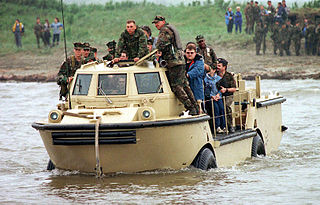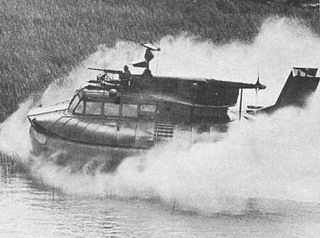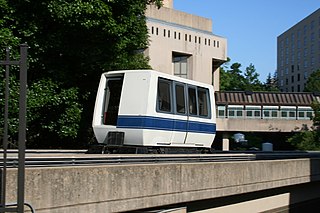
A radio-controlled model is a model that is steerable with the use of radio control. All types of model vehicles have had RC systems installed in them, including cars, boats, planes, and even helicopters and scale railway locomotives.

A hovercraft, also known as an air-cushion vehicle or ACV, is an amphibious craft capable of travelling over land, water, mud, ice, and other surfaces.

An amphibious vehicle, is a vehicle that is a means of transport, viable on land as well as on water. Amphibious vehicles include amphibious bicycles, ATVs, cars, buses, trucks, combat vehicles, boats and hovercraft.

Sir Christopher Sydney Cockerell CBE RDI FRS was an English engineer, best known as the inventor of the hovercraft.
Cushioncraft Ltd was a British engineering company, formed in 1960 as a division of Britten-Norman Ltd to develop/build hovercraft. Originally based at Bembridge Airport on the Isle of Wight, Cushioncraft later moved to the Duver Works at St. Helens, these works gave ready access to the sheltered water of Bembridge Harbour.
A hover car is a personal vehicle that flies at a constant altitude of up to few meters above the ground and used for personal transportation in the same way a modern automobile is employed. It usually appears in works of science fiction.
A Surface Effect Ship (SES) or Sidewall Hovercraft is a watercraft that has both an air cushion, like a hovercraft, and twin hulls, like a catamaran. When the air cushion is in use, a small portion of the twin hulls remains in the water. When the air cushion is turned off, the full weight of the vessel is supported by the buoyancy of the twin hulls.
A personal hovercraft is a small hovercraft normally carrying fewer than 10 passengers. The low cost makes it affordable for personal use.

The Saunders-Roe SR.N1 was the first practical hovercraft. The concept has its origins in the work of British engineer and inventor Christopher Cockerell, who succeeded in convincing figures within the services and industry, including those within British manufacturer Saunders-Roe. Research was at one point supported by the Ministry of Defence; this was later provided by the National Research Development Corporation (NRDC), who had seen the potential posed by such a craft.
Melville Whitnel Beardsley was the American inventor and aeronautical engineer whose pioneering efforts may have contributed to the invention of the Hovercraft.

An air caster is a pneumatic lifting device used to move heavy loads on flat, non-porous surfaces. Its operation is similar to a hovercraft, as it uses a thin layer of air as a way to float a very small distance off the ground. Compressed air enters an airbag shaped like a torus, and when the bag is filled it creates an airtight seal with the ground, and forces more air into the center of torus, eventually causing the air to flow over the bag and to raise the load above the ground.

An air-cushioned landing craft, also called an LCAC, is a modern variation on the amphibious landing boat. The majority of these craft are small- to mid-sized multi-purpose hovercraft, also known as "over the beach" ("OTB") craft. This allows troops and material to access more than 70 percent of the world's coastline, while only approximately 15 percent of that coastline is available to conventional boat-type landing craft. Typical barriers to conventional landing craft are soft sandy beaches, marshes, swampland, and loose surfaces. Air cushion technology has vastly increased the landing capability of the craft, providing greater speed and flexibility over traditional landing craft.

The Saunders-Roe SR.N6 hovercraft was essentially a larger version of the earlier SR.N5 series. It incorporated several features that resulted in the type becoming one of most produced and commercially successful hovercraft designs in the world.

The British Hovercraft Corporation AP1-88 is a medium-size hovercraft. In a civil configuration, the hovercraft can seat a maximum of 101 passengers, while as a troop carrier, it can transport up to 90 troops. When operated as a military logistics vehicle, the AP1-88 can carry a pair of Land Rovers, a Bv202 tracked vehicle and trailer unit or up to roughly 10 tons (10,000 kg) of cargo.

The Saunders-Roe SR.N5 was a medium-sized hovercraft which first flew in 1964. It has the distinction of being the first production-built hovercraft in the world.

The British Hovercraft Corporation BH.7 was a medium size hovercraft. It was the first quantity-production hovercraft to be specifically developed for military applications.

Tracked Hovercraft was an experimental high speed train developed in the United Kingdom during the 1960s. It combined two British inventions, the hovercraft and linear induction motor, in an effort to produce a train system that would provide 250 mph (400 km/h) inter-city service with lowered capital costs compared to other high-speed solutions. Substantially similar to the French Aérotrain and other hovertrain systems of the 1960s, Tracked Hovercraft suffered a similar fate to these projects when it was cancelled as a part of wide budget cuts in 1973.

A hovertrain is a type of high-speed train that replaces conventional steel wheels with hovercraft lift pads, and the conventional railway bed with a paved road-like surface, known as the track or guideway. The concept aims to eliminate rolling resistance and allow very high performance, while also simplifying the infrastructure needed to lay new lines.

The Ship-to-Shore Connector (SSC), also known as the LCAC 100 class, is a system proposed by the United States Navy as a replacement for the Landing Craft Air Cushion (LCAC). It will offer an increased capacity to cope with the growing weight of equipment used by the United States Army and Marine Corps. As of 2015, the program is forecast to cost a total of US$4.054B for 73 hovercraft.
The Resonance method of ice destruction means breaking sheet-ice which has formed over a body of water by causing the ice and water to oscillate up and down until the ice suffers sufficient mechanical fatigue to cause a fracture.













